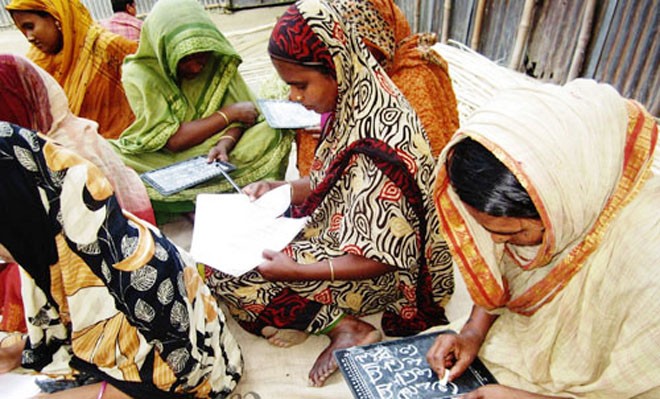
Sri Lanka, India, and Bangladesh seem to be in a race for increasing their adult literacy rate

South Asian countries have been trying to increase adult literacy rate by making and implementing adult literacy plans. But not each of them has been equally successful. For example Pakistan, has perhaps the lowest adult literacy rate of around 54.90 per cent, even a little less than Bangladesh which is at 57 per cent, according to UNESCO figures. India performed better as its adult literacy rate stood at 74.04 per cent in 2011.
But it is Sri Lanka that tops the list of South Asian countries providing adult literacy to the highest number of people. Sri Lanka’s adult population has a literacy rate of 92 per cent. It has the highest literacy rate in South Asia and one of the highest literacy rates in Asia. Literacy rate of adult females in Sri Lanka was reported at 89.07 in 2008, according to the World Bank. Adult literacy rate of males in Sri Lanka was reported at 92.24 in 2008, according to the World Bank.
India’s adult literacy rate was 74.04 per cent in 2011. According to Department of School Education and Literacy, Ministry of Human Resource Development, Government of India, "With the objective of promoting adult education, a series of programmes have been introduced since the First Five Year Plan, the most prominent being the National Literacy Mission (NLM), that was launched in 1988 to impart functional literacy to non-literates in the age group of 15-35 years in a time bound manner." India had a literacy rate of 65.2 per cent in 2008, according to UNDP figures.
The department further says that "By the end of the 10th Plan period, NLM had made 127.45 million persons literate, of which, 60 per cent were females, 23 per cent belonged to Scheduled Castes (SCs) and 12 per cent to Scheduled Tribes (STs)."
India’s Bureau of Adult Education and National Literacy Mission under the Department of School Education and Literacy of the Ministry of Human Resource Development, functions as the Secretariat of the National Literacy Mission Authority. The Directorate of Adult Education provides necessary technical and resource support to the NLMA. It imparts literacy to non-literates in the age group of 35-75 years. The Total Literacy Campaign is the principal strategy of the NLM for eradication of illiteracy.
The India Census of 2001 revealed gender and regional disparities in literacy. Therefore, to bolster Adult Education and Skill Development, the government of India introduced two schemes, namely Saakshar Bharat and Scheme for Support to Voluntary Agencies for Adult Education and Skill Development, during the 11th Plan.
Saakshar Bharat, the new variant of earlier NLM, planned to raise literacy rate to 80 per cent, to reduce gender gap to 10 per cent and minimise regional and social disparities, with focus on women, minorities, and other disadvantaged groups.
The 2013/14 Education for All Global Monitoring Report said India’s literacy rate rose from 48 per cent in 1991 to 63 per cent in 2006, the latest year it has available data, but population growth cancelled the gains so there was no change in the number of illiterate adults.
On the flipside though, India has the highest population of illiterate adults at 287 million, says UNESCO. It further says that the richest young women in India have achieved universal literacy but the poorest are projected to only do so around 2080, noting that huge disparities within India point to a failure to target support adequately towards those who need it the most. "Post-2015 goals need to include a commitment to make sure the most disadvantaged groups achieve benchmarks set for goals," the report adds.
Ever since its inception, the NLM has taken measures to strengthen its partnership with NGOs and to evolve both institutional and informal mechanisms to give voluntary organisations active promotional role in the literacy movement. Now under the scheme of Support to NGOs they are encouraged and provided with financial assistance to run post literacy and continuing education programmes.
In Bangladesh, total adult literacy rate was 52.5 per cent, according to estimates of 2012. Bangladesh has hit most of the UN Millennium Development Goals (MDGs) targets ahead of the 2015 deadline, but will miss 11 indicators, including adult literacy, according to reports. Bangladesh aims to achieve MDGs covering adult literacy rate of 90 per cent by the end of 2015.
To meet adult literacy targets, about 330 NGOs are directly involved in the non-formal education programmes of the government aiming to cover nearly 30 million adult learners. Bangladesh is now implementing the National Action Plan II (NPA II), 2003-2015.